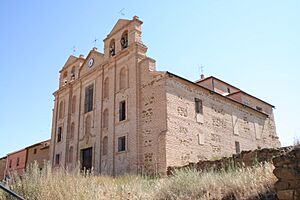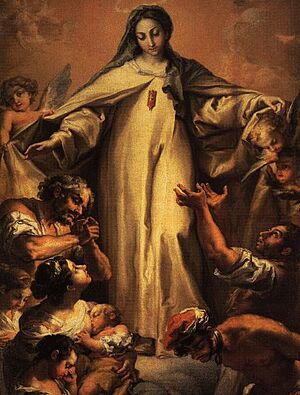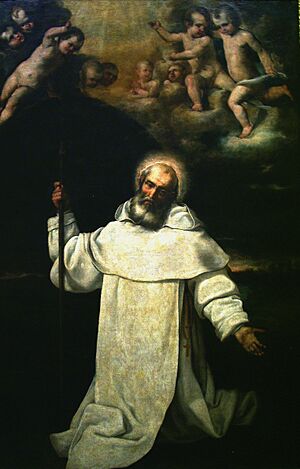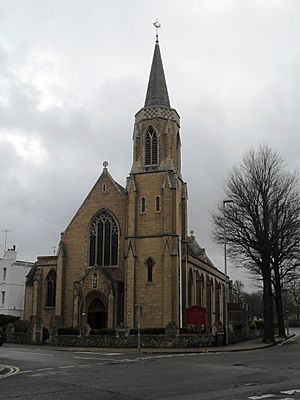Order of the Blessed Virgin Mary of Mercy facts for kids
|
Ordo Beatae Mariae de Mercede redemptionis captivorum
|
|
 |
|
| Abbreviation | O.de M. |
|---|---|
| Formation | 1218 |
| Type | Catholic religious order |
| Headquarters | Rome, Italy |
|
Master General
|
Juan Carlos Saavedra Lucho (2016 - ) |
|
Key people
|
Peter Nolasco, founder |
| Website | Mercedarian Friars, 2 |
The Royal, Celestial and Military Order of Our Lady of Mercy and the Redemption of the Captives, often called the Mercedarians, is a Catholic religious group. It was started in 1218 by Peter Nolasco in Barcelona, Spain. Their main goal was to free Christians who had been captured.
Members of this group are known as Mercedarian friars (men) or nuns (women). A special thing about the Mercedarians is their fourth vow. This vow means they promise to give their own lives, if needed, to save someone who is in danger of losing their faith. Today, the Order exists in 17 countries around the world.
Contents
Why the Mercedarians Started
Between the 700s and 1400s, there were many wars in Europe. Christian kingdoms in Southern Europe often fought against Muslim groups in North Africa and parts of Spain. People living near the coast, like in Catalonia, were always at risk of being captured. Pirates and armies from both sides would often raid towns.
These fights led to many war prisoners on both sides. Captured Christians were often made into slaves. In those times, buying and selling captives was common. Merchants would even travel far to buy slaves. Slaves were a big part of trade between Christian and Muslim ports.
Many groups tried to help people in need. Hospitals and places for the sick were set up by churches or other religious orders. Local groups also created places to help the poor. But the Mercedarians focused on a specific problem: freeing Christian captives.
Peter Nolasco: The Founder
Not much is known about the early life of Peter Nolasco, who started the Mercedarian Order. But we do know he cared deeply about Christians captured by Muslim raiders. He decided to create a religious group to help these people.
Nolasco began helping to free Christian captives around 1203. After 15 years, he and his friends saw that more and more Christians were being captured. He wanted to create a strong, organized religious order. This new group would focus on freeing captives, with the help of the Virgin Mary.
Starting the Order
The Order of the Blessed Virgin Mary of Mercy was one of many groups formed in Europe in the 1200s. These groups focused on helping others. The Mercedarians' special job was to free poor Christian captives (slaves) held by Muslims. This was especially important along the border between the Crown of Aragon (Christian Spain) and al-Andalus (Muslim Spain).
Peter Nolasco's group wanted to help ordinary people who couldn't pay for their own freedom. They called these people the "poor of Christ."
How the Order Began (Traditional Story)
The story says that around 1218, Peter Nolasco and King James I of Aragon both had a vision of the Virgin Mary. She asked them to start a religious order to rescue Christian captives. Nolasco's spiritual advisor, Raymond of Penyafort, helped him with this idea. King James also supported the plan.
On August 10, 1218, the new religious order was officially started. This happened at the Cathedral of Santa Eulalia in Barcelona. Bishop Berenguer de Palou gave Nolasco and his friends their white religious clothes. He also told them to follow the Rule of Saint Augustine for their daily lives. The symbol of his cathedral, the Holy Cross, was put on their clothes. Nolasco and the first Mercedarians then made their religious promises to the bishop. Their first home was the Monastery of St. Eulalia, which also welcomed freed captives.
What Records Show
Historical records tell a slightly different story. The year 1218 isn't mentioned in the earliest documents. Peter Nolasco first appears around 1226, collecting money for captives. By 1230, he was leading a small group of lay people (not priests) in Barcelona.
On August 12, 1230, a man named Maimó Gombal left money in his will for Nolasco to free captives. This is the first time Nolasco's work is mentioned in official papers. We don't know much about him before this.
Over the next six years, Nolasco's group slowly became a religious order. They gained property in Catalonia. The Order grew especially well in the Kingdom of Valencia. This area was a border zone with new land for Christians and many opportunities to free captives. The king and other wealthy people often gave land to the new Order.
In 1236, Pope Gregory IX officially recognized the Mercedarians as a religious order. They followed the old Rule of St. Augustine. The Order grew more in the 1250s and 1260s. This growth likely happened because they were actively freeing captives in a war zone.
King James I, who some later claimed founded the Order, didn't have much contact with them until the late 1230s. He later gave them land in Valencia. Royal support became clearer in the 1250s. The king gave them special protection and economic benefits.
Rules of the Mercedarian Order
The first official rules of the Mercedarian Order, from 1272, highlight three main things: the Order's name, its founder, and its purpose.
The Order was known by different names at first. But the 1272 rules gave it a longer name: The Order of the Virgin Mary of the Ransom of Captives of St. Eulalia of Barcelona. The full name we use today, Order of the Virgin Mary of Mercy of the Redemption of Captives, became common later.
The 1272 rules also clearly state that Nolasco was the founder. He was called the "servant, messenger, founder and promoter" of the new group.

Finally, the rules clearly say the Order's purpose is "to visit and to free Christians who are in captivity and in power of the Saracens or of other enemies of our Law." It also says that all brothers of the Order "must always be gladly disposed to give up their lives, if it is necessary, as Jesus Christ gave up his for us."
Changes and Reform
In the 1400s, some Mercedarian monasteries wanted to live a stricter life. They wanted to follow the Rule of St. Augustine more closely. This idea spread and was approved by the Order's leader.
Later, during the Counter-Reformation (a time of renewal in the Catholic Church), this goal was pushed further by Friar John Baptist of the Blessed Sacrament. In 1603, a small group of friars were allowed to start their own monastery under his leadership. They lived a simpler life and wore simpler clothes and only sandals. They became known as the Mercedarian Recollects, and later as Discalced Mercedarians (meaning "barefoot" Mercedarians). They were approved as a separate branch of the Order in 1621. Eventually, they became a completely independent Order.
The Fourth Vow
Many religious orders take three main promises: poverty, chastity, and obedience. But some orders add extra promises, called "vows." These extra vows are part of what makes each order special.
The Fourth Vow of the Mercedarian Order is a very serious promise. It means a deep commitment to their mission. It is a promise made from the heart, showing a strong will to help others.
The Fourth Vow in the Rules
The idea of the Fourth Vow has been part of the Mercedarian rules since the beginning:
- First Rules (1272): "...all the brothers of the Order must always be gladly disposed to give up their lives, if it is necessary, as Jesus Christ gave up His for us..."
- Later Rules (1327): Mentioned giving up one's life as a hostage in Muslim lands.
- Later Rules (1588): "I will be obedient to you and your successors up to death; and I will remain in person in the power of the Saracens if it be necessary for the Redemption of Christ's Faithful."
- Later Rules (1692 and 1895): Explained that all Mercedarians must be ready to free captives, collect money for them, or do anything else needed for redemption. They also said this vow is "essential" to the Order.
- Modern Rules (1970 and 1986): Reaffirmed that Mercedarians promise to give their lives, if needed, to free Christians from new forms of slavery who are in danger of losing their faith. This means helping people who are trapped in ways that threaten their belief.
Our Lady of Ransom
A special feast day was created to honor Our Lady of Ransom. It is celebrated on September 24. At first, only the Mercedarian Order celebrated it. Later, it spread to Spain and France. In 1696, Pope Innocent XII made it a feast day for the whole Catholic Church.
Special Patronage
Our Lady of Ransom is the main patron saint of Barcelona. Her feast day is also celebrated in all of Spain. In England, she is honored as "Our Lady of the Dowry." People pray to her to help England return to the Roman Catholic Church.
In the Philippines, one of the oldest places where people honor Our Lady of Mercy is in Bahay Pare. People there call her "Nuestra" or "Apung de la Merced." They ask her to help with their health, families, studies, and to inspire more people to become priests or nuns. In Mercedes, Catbalogan, people pray to Nuestra Señora de las Mercedes for protection against raiders.
See also
 In Spanish: Orden de la Merced para niños
In Spanish: Orden de la Merced para niños
- Scapular of Our Lady of Ransom
- Our Lady of Mercy
- Trinitarian Order
- Santa Maria della Mercede e Sant'Adriano a Villa Albani, Rome





